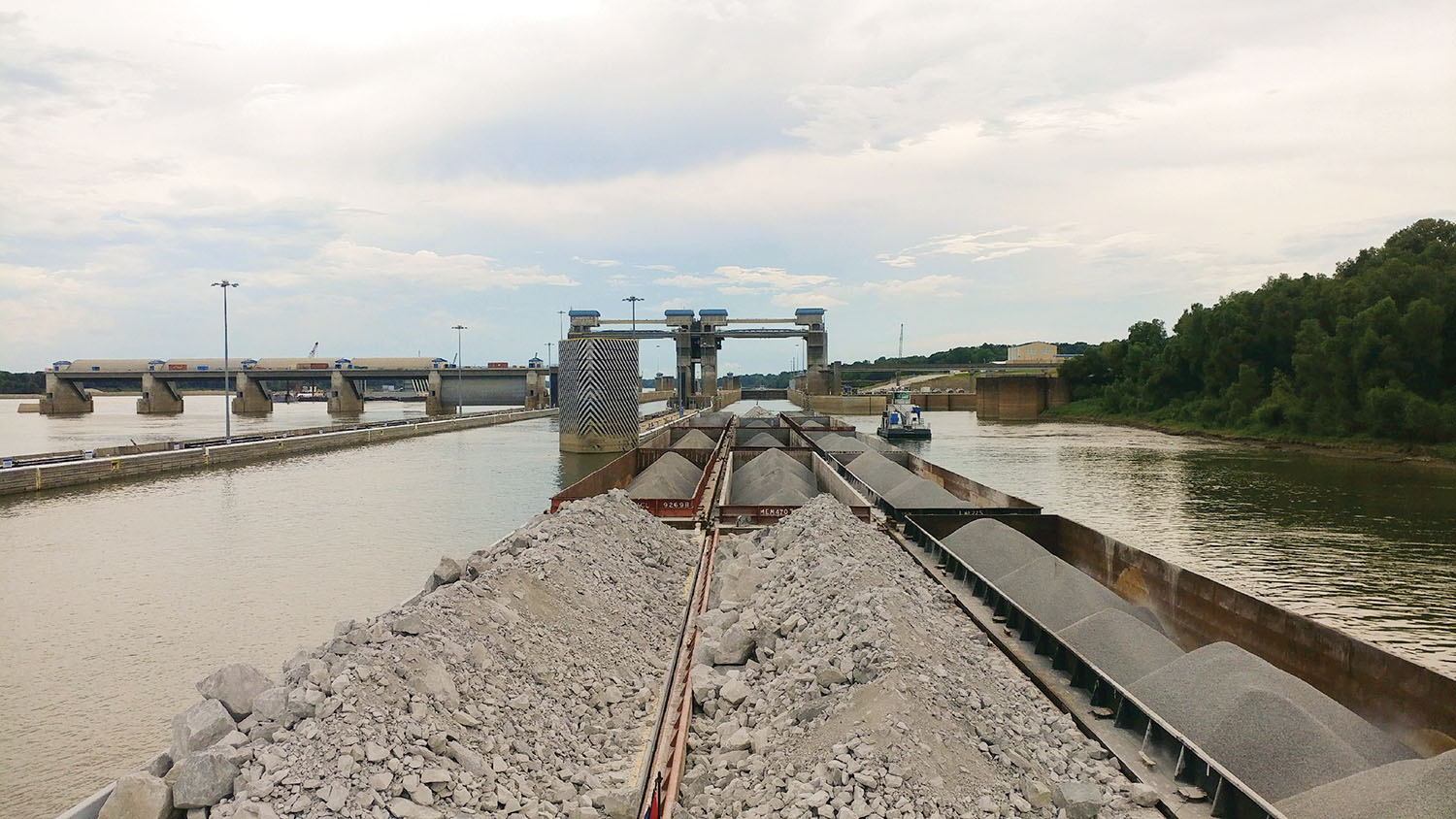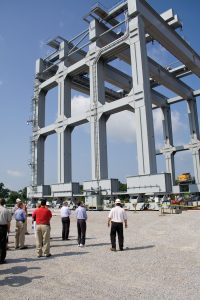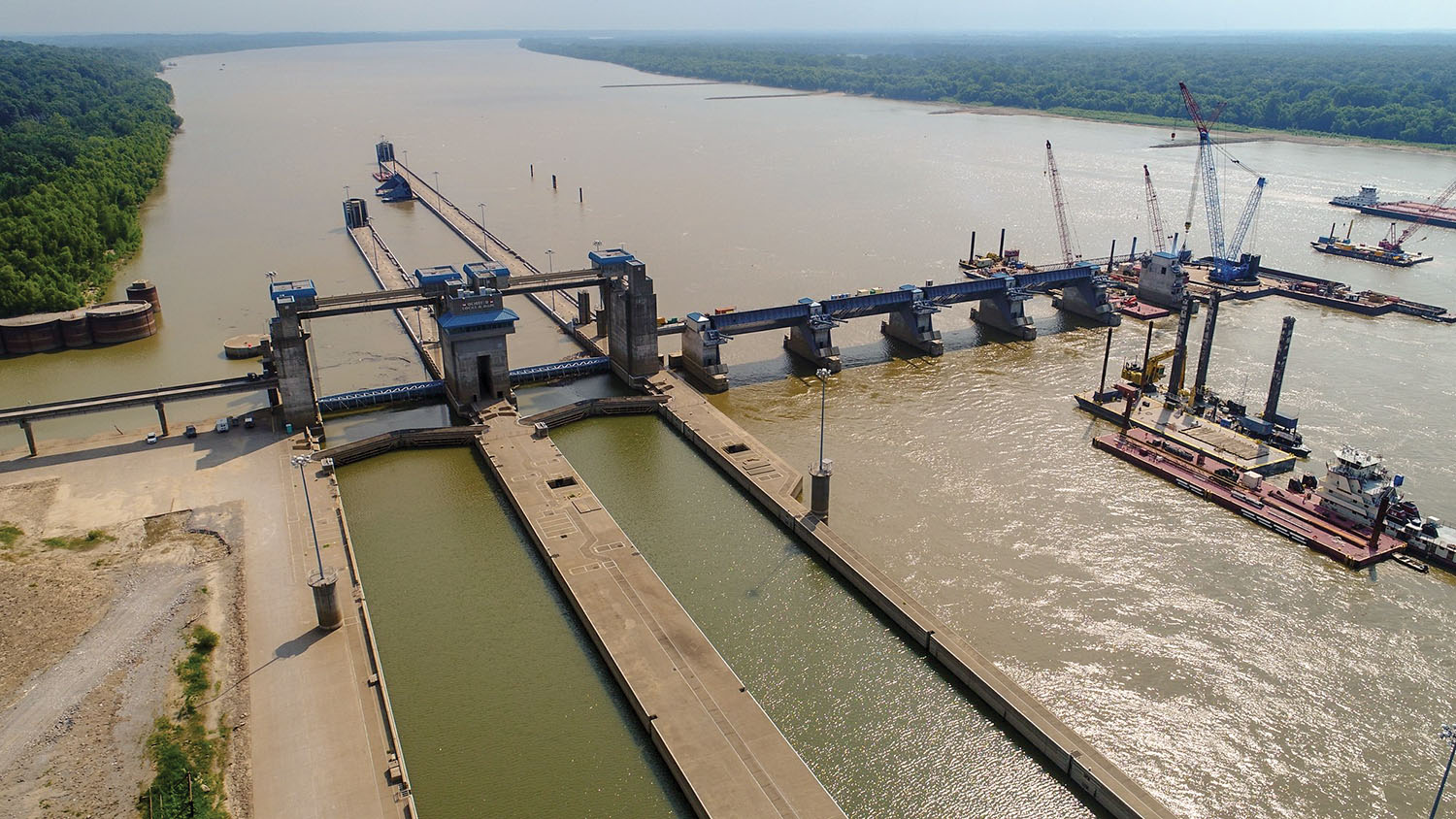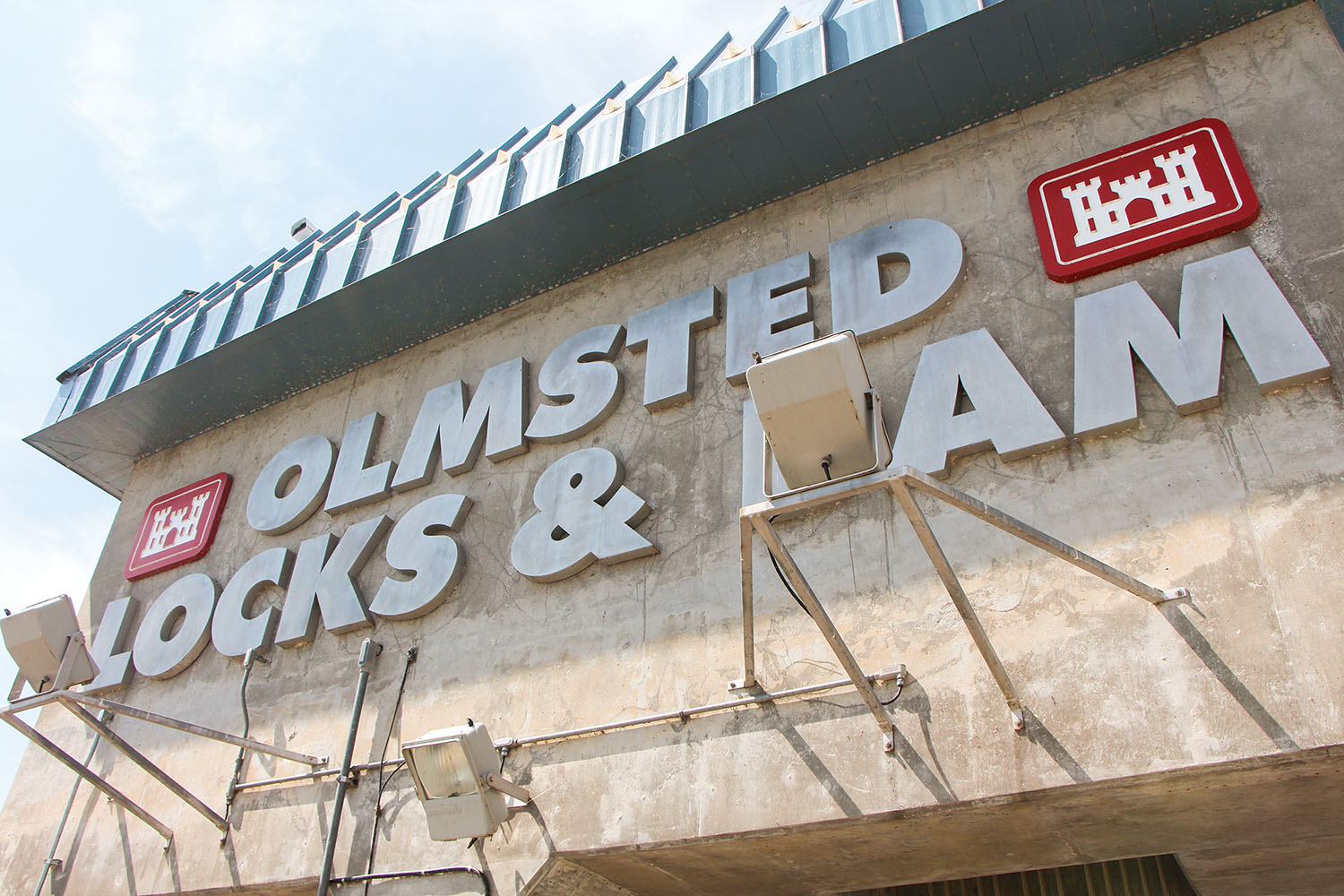In front of a crowd of about 250 elected officials, contractors and industry supporters, the Corps of Engineers formally dedicated Olmsted Locks and Dam on the lower Ohio River August 30.
As a group of dignitaries pressed a large red Corps button, the lockmaster sounded the horn and the lock gates opened, breaking a gigantic red ribbon and allowing the tow of the mv. Glenn W. Jones of American Commercial Barge Line to enter the lock, marking the ceremonial first lockage.
The ribbon-cutting was some 30 years in the making, and it marked the ceremonial—if not the actual—completion of the largest civil works project in the history of the Corps. The $3 billion project required numerous engineering innovations and sapped the Corps’ budget for years, until industry and Corps leaders worked out a funding plan to speed completion of construction.
The new facility will replace Locks and Dams 52 and 53, which were built in 1929 and are rapidly deteriorating.
The opening came not a moment too soon. On August 24, the Louisville Engineer District told the River Industry Executive Task Force that a miter gate problem at Lock 52 almost caused another full closure at the key chokepoint. Late in the day, the district canceled a proposed 48-hour closure, because the Corps had decided to start raising the Olmsted wickets to hold pool due to receding river stages.
The deconstruction of Lock 53 has already begun, rendering it unusable. Locks 52 and 53 were completed in 1929, and their temporary 1,200-foot-long lock chambers were added in 1969 at 52 and 1979 at 53.

The scheduled last-minute river closure illustrates the urgency with which ongoing infrastructure issues at other locks and dams must be addressed.
Olmsted’s inauguration is being welcomed with relief by the Corps of Engineers and by businesses that take advantage of water-borne transportation—which means most businesses, in one way or another. The Corps estimates the annual net benefits of the completed project at $640 million.
The barge industry itself has more of a reason, and a right, to celebrate than anyone else. Without the involvement of its leaders, America and its businesses might still be waiting four or more years for the opening. In the meantime, breakdowns at Locks 52 and 53 would have multiplied, highways would have clogged with thousands of extra trucks, exports would have dragged, and trade flows would have suffered substantial “transportation taxes” across many states.
The first impacts of the Olmsted opening will be immediately felt by Ohio River traffic. More than 800 tows have been delayed by 20 or more hours at Lock 52 since July 14 alone, according to Marty Hettel, vice president of government affairs at American Commercial Barge Line and Inland Waterways Users Board (IWUB) member. Hettel estimated total costs of delays at Locks 52 and 53 from November 2017 through September 2018 at about $75 million.
Even without delays, it normally takes between one and two hours to lock through Locks 52 and 53. Locking through a fully operational Olmsted should take no longer than 30 minutes.
Lessons Learned
Rather than simply celebrate the opening, however, barge industry leaders hope that the lessons of the Olmsted project can be learned well enough by the Corps of Engineers and Congress so that no single project will ever again be allowed to take so long nor monopolize waterways infrastructure resources as this one did.
Until 1978, all lock and dam projects had been fully funded by the federal government. But in that year, after years of discussion, the Inland Waterways Revenue Act established a funding partnership between the barge industry and the federal government. Barge operators funded the Inland Waterways Trust Fund (IWTF) with a fuel tax. The fund began contributing to selected lock and dam projects on a 50/50 basis.
As part of the partnership, the IWUB, a congressionally chartered advisory committee, was established to monitor and provide input on how the IWTF was spent. Since half of that money came from the end-users, the barge and towing companies, its members included barge industry executives.
Its supervisory mandate made the IWUB the single most important among the several chartered advisory boards concerned with waterways policy. By accepting voluntary taxation, under the policy the barge industry called “you pay, you say,” it now had a voice in Corps decisions about projects that it didn’t have before.
DINAMO
In 1981, an organization called DINAMO—the Association for the Development of Inland Navigation in America’s Ohio Valley—was formed. Barry Palmer became its first and only executive director. That same year, the Chief of Engineers released a blueprint for lock and dam capital projects. Among the list of projects deemed necessary to be completed by the year 2000 was Olmsted Locks and Dam.
Those were the days when members of Congress were able to insert project funding directly into bills in the process known as earmarking. During his 22-year tenure with DINAMO, Palmer and his group advocated for construction authorization of waterway projects on the Ohio River and its tributaries including the Robert C. Byrd, Grays Landing, Point Marion, Winfield, Olmsted, McAlpine, Lower Mon, Marmet, London, Kentucky, Greenup and John T. Myers lock projects. Also included was major rehabilitation of Emsworth, Dashields, and Montgomery locks and dams in the mid 1980s.
In 1983, DINAMO merged with the Ohio Valley Improvement Association, and merged in 2003 with Waterways Council Inc., whose president and CEO Palmer became, retiring in 2008.
Palmer was present at the Olmsted groundbreaking ceremony in 1996 with Sen. Wendell Ford (D-Ky.), an early champion of the project. He was also present at the Olmsted dedication last week. The previous evening, at a dinner at the Paducah Country Club for those associated with Olmsted, Palmer said, “The completion of the Olmsted Locks and Dam Project, the largest public works project in the nation, is a testament to the tenacity and persistence of the men and women whose vision, passion and hard work over a long period of time has paid off. For me, this tremendous Olmsted replacement project, costing more than $3 billion, is all about the people I worked with over 28 years of my life: the planners and engineers at the Ohio River Division, the Louisville and Huntington districts, and Corps headquarters, the assistant secretaries of the Army and their staffs, the businessmen and women, and the congressmen and senators and their staffs.”
The Project That Ate The Waterways
The partnership between industry and the Corps seemed to work fine—until Olmsted became “the project that ate the waterways” and monopolized most of the funding from the IWTF, choking funding off from other necessary projects.
When the Olmsted project was first authorized in 1988, the two locks it was designed to replace, 52 and 53, were already 60 years old. The first congressional authorization estimated a total cost of $775 million; the project’s original feasibility report assumed a seven-year construction, with a completion date of 1992.
But as the project became more complex and funding streams less regular, its estimated costs grew to more than $3 billion and completion dates kept getting pushed back. At one point, its projected completion date was somewhere between 2022 and 2026.
For the Corps, the Olmsted project has been its single biggest and most significant engineering challenge to date. It took almost 30 years to build, or three times longer than the American work on the Panama Canal (not counting the French preliminary work).
By comparison—as pointed out by Mark Knoy, president and CEO of American Commercial Lines and a former IWUB member—during a 31-year period from 1963 through 1994, the Corps built the McClellan-Kerr system, the Tennessee-Tombigbee system, and the J. Bennett Johnston Waterway, which, taken together, cover 915 miles of waterways and include 33 locks and dams. On Olmsted, said Knoy, “We ended up spending four times as much and it took six times longer than we thought it would.”

Innovations
The Olmsted technical innovation that attracted the most attention, and created the most controversy, was the “in-the-wet” construction method. Traditional techniques require using cofferdams as temporary dams to create a large dry space around the work site so that dam cells could be poured in place. The lock portions of the project, completed in 2004, were built “in the dry, behind a traditional cofferdam. The “in-the-wet” method involved casting dam sections ashore and moving them into place using barges.
The Corps had had some success using this method at the Lock No. 2 at the Braddock Dam on the lower Monongahela River. Corps officials told IWUB members that they could save $67 million by using in-the-wet construction at Olmsted. The Corps argued that it would have far less impact on barge traffic. Safety was another consideration; the in-the-wet method exposed far fewer workers to hazards.
But conditions were far different at the Olmsted site. The lower Mon was a narrower river with less flow. The Ohio River at Olmsted sits directly atop the New Madrid Fault and is the single busiest lock on the inland rivers.
The unknown risks of the site and the new technique meant that when the Corps first opened bids, no contractor could be bonded by insurers. The Corps ultimately had to let contracts on a “cost-reimbursable” basis, meaning it had to let contractors build in cost increases as they occurred.
The project consists of two locks, each measuring 110 feet wide by 1,200 feet long, adjacent to the Illinois bank; a dam composed of five tainter gates; and 1,400 feet of steel wickets in the navigable pass section that can be manually raised by wicket boats to help impound the pool. Eighteen dam tainter gate shells were set in the river bottom to support the tainter gates. Twelve shells were set for the navigable pass section.
Some of the increased costs of the in-the-wet method came because so many of the tools used were purpose-built and unique. Pre-cast concrete dam shells were built on land and barged into place. In order to move the shells, a special purpose-built gantry crane was constructed, capable of lifting 5,300 tons. A specially built “aqua-digger” was used to prepare the river bottom for the shells. Each shell had 500 sensors built in to enable the correct placement of special concrete, called tremie concrete, into any void spaces after placement. The project team used GPS technology to place the shells to within quarter-inch tolerances.
Because of the project’s siting on the New Madrid Fault, another Olmsted innovation is the use of special isolation joints between sections of the project to allow the lock and dam structure to flex somewhat in the event of an earthquake.
At one point, the project team considered having the dam’s wickets raised and lowered hydraulically, instead of manually by wicket boats. But that innovation, too, found no bidders. The project team ultimately realized that the cost was prohibitive and the hydraulic wickets would have required too much maintenance.
As work progressed and learning curves were mastered, the work became more efficient. Since the last cost estimates, an estimated $330 million has been saved, the Corps says.
In 2015, several Olmsted team members earned the Corps’ Innovation of the Year Award for inventing a “self-consolidating concrete” and new techniques for concrete placement. Other innovations included improved computer modeling that took advantage of rapid advances in processing power. Those techniques are now being used on other Corps projects.
Barge Industry Steps Up
The turnaround in the fortunes of the Olmsted project came about because of initiatives spearheaded by the barge industry.
“In the years 2006 and 2007, the Inland Waterways Trust Fund (IWTF) was dwindling, Corps projects kept lengthening and their costs kept ballooning,” said Stephen Little, chairman of Crounse Corporation, and, at the time, chairman of the Users Board. “The industry was very frustrated. Whenever these concerns were raised, the administration, backed by the Office of Management and Budget [OMB] —and it didn’t matter if it was Republican or Democratic—always seemed to have an easy fix: raise our taxes!”
To barge industry businesspeople, it seemed that Corps projects and districts were competing against each other for too-scarce federal dollars, lengthening each project and building in inefficiencies and cost overruns.
Collaborative Turning Point
Part of the problem that almost doomed Olmsted lay beyond the Corps’ control. It came from the Corps having to husband uncertain and irregular funding streams from Congress, given that years or even decades could pass between a project’s authorization and its funding—and then the funding would as likely as not be inadequate, or just enough to ensure a project’s continuance but not its completion.
Although more money from Congress was clearly needed, that alone would not be sufficient, said Little. “So industry representatives got with Corps officials in 2007 and said, ‘Why don’t you study your projects and determine the causes of their delays?’ It was basically a plea to establish rational priorities, based on objective measures.”
The Corps took up the challenge. The three projects the Corps selected for analysis were Olmsted, the Lower Monongahela Lock and Dam and Marmet Lock and Dam and on the Kanawha River in West Virginia. “The idea was to do a comparative analysis between projects that were relatively successful and cost-effective [like Marmet] and problem projects like Olmsted and figure out what was different between them,” said Little.
After 13 months, the Corps produced a study it presented at an IWUB meeting in July 2008. The report included presentations on each project separately. The Corps called the report “Selected Case Studies”; barge industry members referred to it as “The Good, The Bad and the Ugly.”
“The Corps said, ‘There’s a lot here that we need to work on, and we want your help in doing it,’” said Little. “To be honest, there were a lot of industry people who were skeptical of that plea, because they felt the relationship with the Corps had broken down. Fortunately, cooler heads prevailed.”
But more was needed than simply better allocation of funds. A better business model of cost estimating, capital investment and project delivery was also required. “The Corps agreed with us on that,” said Little. “The Corps went to work and cleaned up their numbers with better estimating and modeling.”
It took another 18 months of intensive collaboration between Corps professional staffers and barge industry representatives—mostly CEOs and top executives—to refine a list of recommendations and priorities.
Although Little spearheaded the effort, he is careful to spread credit around. “It was a true team effort. Many people in our industry spent thousands of man-hours on this very focused and intense effort,” he said. In particular, Little credits team members Matt Woodruff of Kirby Corporation and John Doyle of Jones Walker law firm as two key members of the industry team whose wise counsel and advice were steadfast throughout the process. Also, Rick Calhoun of Cargill performed double duty as both an active member of the team as well as WCI chairman.
“We had team members who traveled to meetings in Pittsburgh, Louisville, Nashville, Houston and St. Louis for these rather intense, detailed sessions, as well as participating in innumerable conference calls,” Little said. “Our ‘A-Team’ also included industry stalwarts like Tim Parker, Mark Knoy and then later in the process, Dan Mecklenborg.”
Another key team member, said Little, was Jeanine Hoey, a Corps project manager who was a professional engineer. “She was smart, able and instrumental in fostering that collaboration. The collaboration between industry and the Corps was effective because it operated at a technical level, below political considerations.”
The result was dubbed the Capital Development Plan. One key recommendation to the Corps that it adopted was to assign cost-benefit ratios to projects and rank their importance accordingly. “The key message was, ‘Let’s finish what we started,’” said Little. “Even those whose projects were farther down the list ended up supporting this process, because they knew that as projects got funded and cleared, their projects would eventually be completed as well.”
In April 2010, Little testified about the plan before a committee of Congress.
Almost Shut Down
Despite the progress in communication between the barge industry and the Corps and the development of the Capital Development Plan, the Olmsted project still came very near to being shut down altogether. When Hettel was appointed chairman of the IWUB as Little’s successor in 2013, after having served as an interim member for a year, he volunteered to become the board’s representative for the Olmsted project—in effect, the barge industry’s point man and watchdog.
“As I began to attend the partnering meetings between the Corps and its contractor,” said Hettel, “I very distinctly remember the Corps laying out a plan to shut down the Olmsted project, due to a Post-Authorization Change Report [cost increase] not being authorized [by Congress]. The Corps came within a couple of months of executing their plan to shut down construction at Olmsted.”
Barge leaders credit Sen. Mitch McConnell (R-Ky.) with eventually getting the Post-Authorization Change approved in Congress, which saved Olmsted from shutdown. McConnell spoke at last week’s ribbon-cutting ceremony.
Turnaround In Congress
The next job was selling the already worked-out Capital Development Plan to Congress. By common acknowledgement, the key player there was Mike Toohey, who had become president of Waterways Council Inc. (WCI) in 2011. “Mike walked this through every step of the way,” said Knoy. A former congressional staffer and assistant secretary of transportation under George W. Bush as well as a former governmental affairs expert at Ashland Oil, Toohey brought a wealth of both governmental and congressional experience.
As leader of WCI, Toohey and his staff worked to develop the Capital Development Plan’s recommendations into a bill with the proper legal language. They worked closely with key members of Congress to ensure that many of the report’s key recommendations became part of the historic Water Resources Reform and Development Act (WRRDA) of 2014. The key items were a one-time change in the federal cost-share for Olmsted from 50/50 to 85 percent federal and 15 percent IWTF, and a voluntary increase in the barge industry’s fuel tax.
A key piece of the plan was the barge industry’s voluntary fuel tax increase from 20 cents per gallon of fuel to 29 cents, or a 45 percent increase. It was actually included not in the WRRDA itself, but in a separate bill passed in Congress’ 2014 lame-duck session. In an irony that Hettel says “could only come out of Washington,” that bill was titled the Tax Increase Prevention Act.
When selling its package of voluntary taxation coupled with spending reform and an increase in federal cost-share for Olmsted, the barge industry had to contend with some Republican members of Congress who opposed the bill because they were philosophically opposed to any tax increases. At one point, Toohey enlisted the help of anti-tax activist Grover Norquist—at the time influential with some more recently elected Republican members of Congress—to persuade the Republican holdouts that it was OK for the government to raise taxes for infrastructure—especially if the ones being taxed were willing!
WRRDA 2014 broke the funding logjam and enabled progress to resume on Olmsted. Organized labor and farm interests gave much help and support, according to Gary Niemeyer, president of the National Corn Growers’ Association. As Rick Calhoun, past chairman of WCI and president of Cargill Marine & Terminal Inc., put it, the 2014 bills “ended the ‘trickle factor’ that had held back contractors.”
Thanks to the barge industry’s behind-the-scenes work, the 2014 WRRDA bill was a not only a testament to what bipartisanship in Congress can do even in a partisan time, but a true watershed for waterways infrastructure funding.
It was important for much more than Olmsted itself. By freeing up IWTF funds and accelerating the completion of Olmsted, WRRDA 2014 allowed full and secure funding for the completion of the Kentucky Lock and Dam Project, the Chickamauga Lock and Dam Project and the Lower Mon Project as well.
For Knoy, the ultimate lesson of Olmsted is, “We can get stuff done with proper champions.”




